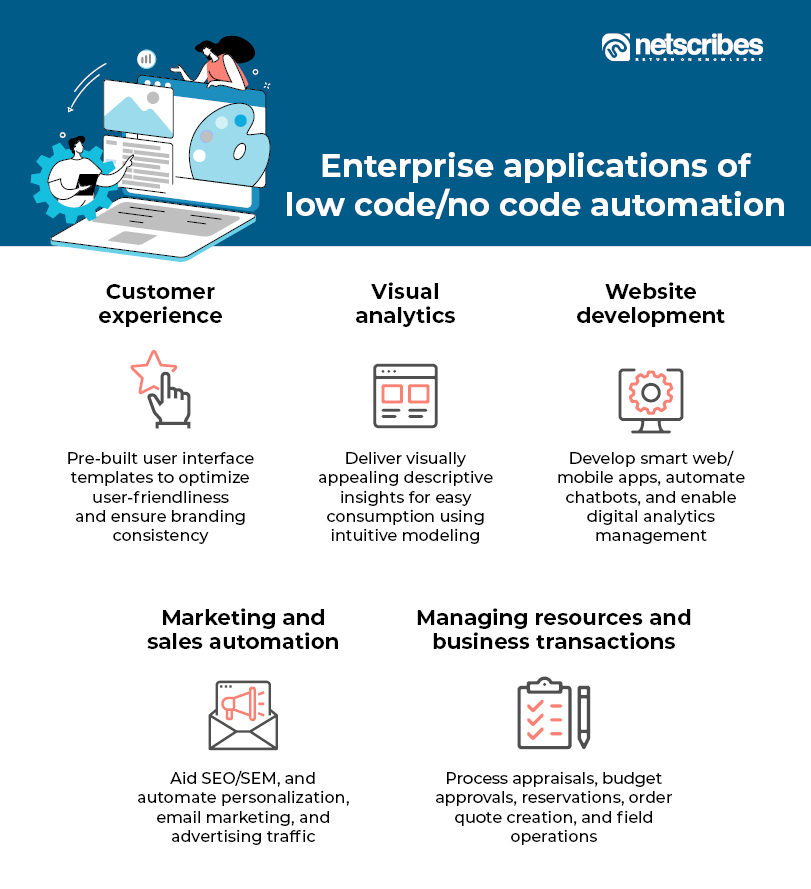Good Facts For Picking Legacy application modernization with Low-code
Wiki Article
Benefits Of Low-Code Application Development In Terms Of Integration Capabilities
Low-code application integration offers many advantages, including the ability to seamlessly integrate various platforms and services. Here are the benefits of APIs and connectors that are pre-built:
A Wide Variety of Connectors The Low-code software typically includes a library of prebuilt connectors to popular enterprise applications (e.g. databases, CRMs, ERPs, cloud services). It simplifies the integration with these systems.
API Integration - A lot of low-code platforms include API integration, which gives developers to easily access other data sources or external services.
Easy to utilize
Drag-and-Drop Integration integration tasks can usually be completed using drag-and-drop interfaces, which makes it easy for both developers and non-developers to design complicated integrations without writing a lot of code.
Visual Workflow Builders : Software to create workflows and data flows that are visually represented help to comprehend and setup integrations in a more intuitive way.
Standardized Integration Methods:
SOAP and RESTful Service Support for web service standards such as REST and SOAP facilitates easy integration with a variety of external systems.
OData and various Standards Standards that support them like OData allows for the easy access and manipulation of data on various platforms and applications.
Real-Time Data Synchronization:
Real-Time Integrations: Low code platforms are capable of handling the real-time synchronization of data among systems, applications and databases. This will ensure that data is up-to-date and consistent throughout an organisation.
Event-Driven Architecture: Certain platforms can support event-driven architectures. permitting applications to respond to events in real-time. This is crucial for interactive and dynamic applications.
Legacy System Integration:
Interconnecting Old and New Systems Low-code platforms usually include tools for integration with legacy systems, allowing companies to upgrade their IT infrastructure without radically overhauling the existing system.
Data Migration: Built-in tools allow you to transfer data from old applications to the latest ones developed on platforms that have low-code.
Third-Party Integration of Service:
Cloud Services Integration: Easy scaling and deployment of applications can be achieved through seamless integration with cloud services such as AWS, Azure and Google Cloud.
Business Applications Integration Lowcode platforms can be used to integrate different business applications, such as Salesforce, SAP, Microsoft Dynamics etc. and create a unified workflow among different business functions.
Simplified Data Management:
Unified Data Models Some low-code platforms provide unification of data models, which simplify managing data and integrating across various systems.
Data Connectors: Pre-configured data connectors permit easy access to and manipulation of data derived from diverse sources.
Security and compliance
Low-code integration platforms meet security standards to safeguard the data during transport or in storage.
Compliance Features: These platform typically have features that assure that integrations are in compliance with the requirements of regulatory agencies, like GDPR or HIPAA. This provides peace of mind for businesses that handle sensitive information.
Extensibility:
Custom Codes and Scripts. To meet more intricate requirements in integration, low-code platform usually allows the use of custom scripts and code. This allows flexibility without compromising user ease.
Plug-in Ecosystems: A plug in ecosystem can be utilized to enhance the integration capabilities and permit users to add additional functionalities as needed.
Low-code platforms can be a useful device to build interconnected, effective and scalable applications. These platforms streamline the process of connecting disparate IT systems, increase the flow of data, and aid companies adopt technologies that are already in use, and also make use of new ones. Check out the recommended Low-code Platform for application development for website advice including app platforms, rapid application design, application modernisation, lowcode no code, application development platforms, rapid applications, develop web application, rapid app development, stored sql procedures, cross platform app development and more.

The Benefits Of Low-Code Application Development In Security And Governance
Low-code development of applications offers a variety of advantages when it comes to security and governance, both of which is essential to ensure that applications are compliant and secure. They also ensure that they are well-managed throughout their entire life cycle. These are the main advantages.
Unified Management Console - Low-code platforms provide a central management console for administrators to control and supervise every application. This ensures consistent governance throughout the organization.
Role-Based Access Control RBAC: These platforms are equipped with powerful role-based controls that permit administrators to define access policies. This makes sure that only authorized users have the ability to access or modify particular elements of an application.
Compliance and Regulatory Conformity:
Many low-code platforms come with built-in compliance features. These are designed to ensure that applications comply with the industry standards (e.g. GDPR, HIPAA). They provide tools and frameworks to help ensure that applications are compliant with these requirements.
Audit Trails: Many companies incorporate comprehensive audit and logging trail systems, which allow the organization to monitor changes make, track access and assure the compliance of internal and external regulations.
New Security Measures to Improve Security
Data Encryption Low-code systems typically come with built-in encryption of information in transit and at rest, which protects sensitive data.
Security Certifications - A lot of lowcode providers hold security certifications, such as ISO 27001 (or SOC2), which demonstrate the adherence to high security standards. Users can be assured that these providers adhere to the standards.
Automated Security Updates
Regular updates and patches: Low code platforms usually are capable of handling patches and security updates regularly. This helps ensure that applications are protected against the most recent threats, without developers having to manually handle.
Security Monitoring: Tools to conduct constant security monitoring are available. They send real-time alerts as well as insight into security issues that might arise.
Data Governance
Data Access Policies These platforms permit organisations to create data access rules and enforce the policies, making sure that data is available only to authorized users. They also ensure the data is utilized in a proper manner.
Data Masking, anonymization, and Anonymization Tools: These programs can help protect sensitive personal information and are particularly helpful in testing environments.
Consistent Application Lifecycle Management:
Pipelines for deployment and development: Low code platforms offer integrated pipelines for development and deployment which include security checks. They make sure security is maintained through the entire lifecycle of the application.
Version Control: An integrated version control system helps to track changes and allows any changes that are made to an application to be monitored. If necessary they can be reversed and the integrity of the application maintained.
Authorization, User Authentication and Authorization
Single Sign-On (SSO). Support for advanced authentication and single sign-on is simple and increases security.
Multi-Factor Authentication Most platforms support multi-factor Authentication that adds an additional layer of security when logging into applications.
Monitoring Policy Enforcement:
Low-code platforms come with policy templates predefined that can aid organizations in implementing security and governance guidelines.
Compliance Monitoring Tools - These tools permit continuous monitoring of compliance status and provide the ability to report, making it easier to spot and fix possible issues.
Integrate with existing security infrastructures:
Seamless integration: Low-code platforms are able to be seamlessly integrated with existing security tools and systems such as firewalls and SIEM solutions (Security Information and Event Management), and identity management systems.
API Security API Security: API security features are built-in to make it possible to integrate with external systems, securing the integrity of data as well as ensuring the integrity of applications.
Best Practices and Training
A lot of platforms provide guidelines and best practice to secure development of applications. They assist non-developers to meet security standards.
Security Training Some low code service providers provide security training and resources to users in order to help them understand how to maintain and build secure applications.
Low-code development can provide a range of security and governance benefits which ensure that apps are developed and managed in an efficient way, safe and in compliance. These platforms comprise the tools and frameworks required to supervise and control process of developing applications, and protect sensitive data while maintaining the compliance of regulations and enforcing rules. Take a look at the recommended use this link on Legacy application modernization with Low-code for website examples including stored sql procedures, azure sql, microsoft azure sql, azure sql databases, push notifications, driver jdbc, lowcode no code, lowcode no code, rapid action development, push alerts and more.

The Benefits Of Low-Code Development For Developing Applications In Terms Of Limitations And The Possibility Of Customization
Low-code development provides a balanced approach to addressing limitations, while also allowing for the possibility of personalization. Here are some benefits:
The Challenge of Overcoming Complexity
Simple Development : Low-code platform reduces the complexity of development by providing components and templates that are pre-built. This allows rapid development and deployment.
Many platforms have guided workflows, which assist developers navigate through complicated processes. They decrease the chances of errors and ensure consistency.
Scalability Solutions
Scalability is built into: Low-code platform often includes capabilities that permit the development of scalable architecture. Applications can handle increased workloads with minimal changes.
Performance Monitoring: The instruments which monitor and optimize performance help to make sure that applications run efficiently even as they expand.
Security and Compliance
Low-code platforms come with security features such as security access control that is based on roles encryption, as well as automated checks to ensure security compliance. These measures address the commonly-asked security issues.
Platforms regularly update their security protocols, and ensure compliance with regulatory requirements. This keeps the applications secure from threats that are constantly evolving.
Customization Features:
Extensibility:
Custom Code Integration: Low-code systems often allow the integration of custom code (e.g., JavaScript, Python) that allows developers to enhance the functionality beyond the basic features.
Moduls and plugins that are custom-designed Developers are able to create custom plug-ins or modules that have specific features specifically tailored to the needs of a company.
APIs & Integration:
API Support: A full API support is provided to allow seamless integration and connectivity with external systems.
Third-Party services: Low code platforms have connectors pre-built for popular third-party services. This makes it easier to customize and integrate applications.
Flexible design of UI/UX:
User-friendly interfaces with customizable options: Users can modify and create their own user interfaces, that will give a more tailored experience.
Responsive Design: The apps can be customized to suit different screen sizes and devices.
Business Logic Customization
Visual Workflow Builders Visual tools for creating and customizing workflows as well as business logic enable developers to develop complex, customized processes without extensive code.
Platforms provide conditional logic that can meet specific business rules or scenarios.
Data Management
Custom Data Models: Developers may develop custom data models that meet specific requirements of an application to ensure that data processing is customized to the business needs.
Advanced Data Processing: Integration with sophisticated tools and capabilities for data processing allow customizing how data is analyzed, and utilized within your application.
Balance Customization and Limitations
Frameworks and Standards:
Best Practices: Low-code platform encourages adherence to standards and industry best practices. This helps to ensure high-quality apps that are scalable, secure and reliable.
Governance Frameworks. Inbuilt frameworks for governance make sure that any modifications do not compromise security, compliance or integrity of the application.
Feedback and iterative development:
Rapid prototyping. Developers are able iterate and refine applications based upon feedback from users.
Continuous Improvement: Low-code platforms allow continuous improvement, which allows for constant customization and enhancements when business requirements change.
User Empowerment
Giving Citizen Developers the tools they need: Low-code platforms boost the number of developers who are capable of improving and modifying applications through giving them the ability to modify their applications through an intuitive user interface.
Training and Support Resources: Many platforms provide comprehensive training and support materials to allow users to customize their applications without jeopardizing their performance or stability.
Overall, low-code application development gives a strong framework for addressing limitations as well as a wealth of opportunities to customize. This allows companies to create and maintain applications that work and adapted to the specific needs of business. All while maintaining high quality, security as well as scalability and standards.
